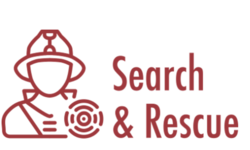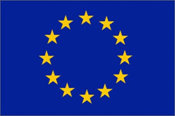Search and Rescue
Search and Rescue: Emerging technologies for the Early location of Entrapped victims under Collapsed Structures and Advanced Wearables for risk assessment and First Responders Safety in SAR operations

The key objective of S&R is to develop and promote the underlying framework, which consists of interoperability amongst systems, equipment, training and awareness, so that responders at all levels of command gain access, familiarize and evaluate how to deploy innovative solutions. The role of DFKI in this project lies in providing a robotic platform which is capable of operating in confined toxic areas as a an addition to K-9s, and developing a system for modelling and mapping gases which are relevant for the assistance of first responders in localizing entrapped victims and detecting dangerous zones.
| Duration: | 01.07.2020 till 30.06.2023 |
| Donee: | German Research Center for Artificial Intelligence GmbH |
| Sponsor: | European Union |
| Application Field: | SAR- & Security Robotics |
| Related Projects: |
ROBDEKON
Robot systems for decontamination in hostile environments
(06.2018-
06.2022)
|
Project details
Rationale
Apart from earthquakes which usually result in catastrophic structural collapses with many people entrapped or killed, e.g. Indonesia 2018, Japan 2011, Haiti 2010, Italy 2009, Greece 1999, there are also other causes that may result in the collapse of a building, such as an accidental explosion or a terrorist attack in public areas or critical infrastructures like airports. Moreover, natural disasters like earthquakes may trigger technological disasters, such as industrial chemical release or fires. This domino effect may pose tremendous risks to the countries and communities, hence it is a great challenge to cope with by the first responders and relevant organizations of civil protection. First responders and rescuers need specialized instrumentations, which are easily accessible, available at all times, and meet stringent requirements in terms of detection accuracy, quick localization, and reduction of false alarms.
The S&R project will design, implement and test a highly interoperable, modular open architecture platform for first responders, capitalizing on expertise and technological infrastructure from both COncORDE and IMPRESS FP7 projects. The governance model of S&R will be designed to operate more effectively, and its architectural structure will allow to easily incorporate next generation R&D and COTS solutions which will be possibly adopted in future disaster management systems. The model will also support a unified vision of the role of the European Union, and will provide a common framework to assess needs and integrate responses. The framework will enable supportive approaches using a wider range of decisional support features and monitoring systems, and will also give an effective and unified vision of the dynamic changes going on during the lifetime of an event and the capabilities and resources currently deployed in the field to first responders.
Ambition
The key objective of S&R is to develop and promote the underlying framework, which consists of interoperability amongst systems, equipment, training and awareness, so that responders at all levels of command gain access, familiarize and evaluate how to deploy innovative solutions. Research and development will continue to produce innovative products, which have to respond to ever growing threats in a globalized environment. The major challenge addressed is to link approaches, technical solutions, procedures, standards, etc. for the protection of the European citizen as defined in the European Internal Security Strategy, thus allowing a faster and more appropriate response to natural, technological and man-made threats in European countries. The S&R project aspires to demonstrate a consistent crisis governance model, naturally supported by the toolbox concept, covering the role that Europe intends to adopt subsequently to the implementation of the new Lisbon Treaty, and also considers a stronger civil-military mutual support in form of technologies and operations, and public-private coordination. Emergency responders from multiple entities organize themselves on the field according to existing procedures, different training means and unsorted equipment at local or national level. These procedures, training means or equipment are not standardised, homogeneous or supplied between the various organisations and nations, hence no system vision exists to bring coherency, efficiency and control. Some crucial gaps in crisis environment response have been identified by the European Comission [e.g. COM(2011)696, COM(2010)600, COM(2009)82], as well as lessons learnt from past emergencies. It is at this level that S&R aspires to make a difference using state-of-the-art technological solutions.
Expected Impact
The impact of S&R towards the international crisis management community will be related to disseminating a new governance concept, which combined with the technological solutions that will be presented by the consortium is related to:
- Production of smaller, lighter rescue tools with increased effectiveness in confined spaces; early detection of toxic environments for the first responders and K-9s. - Reduction of response time; it is the most critical parameter in the recovery of live victims in collapsed building environments.
- Reduction of planning time; it will be reduced by engaging reliable, adaptable technologies for faster disaster scene overview, wide-area situation awareness and imaging using UAVs, thermal cameras, etc.
- Reduction of the incidence rate of injuries for victims; fast extrication providing with medical support based on on-site noninvasive methods.
- Next generation garments; totally textile sensors embedded on first responders’ SMART uniform for situational awareness, as well as health and safety of the first responders.
- The enduring impact of S&R on citizen safety and security, which will be maximized because the science and technology is informed and driven by end users, who will run the pilots in order to assess the added value of S&R solutions.
- Re-introduction of the citizen as a very important active element in the crisis environment.
Enhancement of the culture of preparedness and readiness capability upon disaster risks for the population; inclusion of all people in the disaster management cycle. - Ensurance that the crisis management community has full access to the S&R project in terms of contributing to the considered governance model and eventually participating to the innovative implementation of the toolbox concept, in order for the project results to have a lasting impact on European society.
- Sharing the information collected and the knowledge developed within the project with civil protection and security actors in the EU.
- Providing a comprehensive test-bed organisation, in terms of full scale exercises and demonstrations of simulated complex crisis management situations, that EU bodies and national organisations may use for testing diverse response frameworks allowing for better operational and societal adaptation to rapidly evolving threats.
- Education of end users in the developed S&R toolbox and holistic approach to European crisis management.
Role of DFKI
The role of DFKI in this project lies in providing a robotic platform which is capable of operating in confined toxic areas as a competitive replacement for K-9s, and developing a system for modelling and mapping gases which are relevant for the assistance of first responders in localizing entrapped victims and detecting dangerous zones. This system is to be integrated into an interoperability framework for an easy access of distributed data, and later field-tested in various real environments using a membrane-inlet mass spectrometer provided by project partners.
